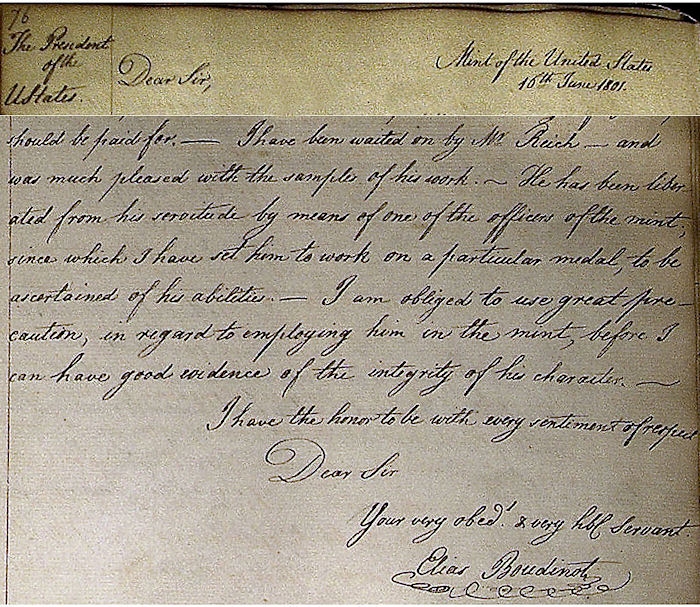Was John Reich once an indentured servant?
 RogerB
Posts: 8,852 ✭✭✭✭✭
RogerB
Posts: 8,852 ✭✭✭✭✭
The following excerpt from a letter by the Mint Director to the President suggests that John Reich came to American as an indentured servant and was liberated by one of the Mint officers in 1801. Thoughts?

2
Comments
Stewart Witham, in his thin book on John Reich, noted that Reich was indentured to a silversmith who worked in Philadelphia.
RMR: 'Wer, wenn ich schriee, hörte mich denn aus der Engel Ordnungen?'
CJ: 'No one!' [Ain't no angels in the coin biz]
Sooooo...If one of the Mint Officers paid off the indenture, and the Director gave him a trial engraving die sinking project, then it would make sense that Reich would accept a small salary at the Mint to stay in the USA..... Or?
That is certainly plausible, especially since he would have been in his 30's at the time. I would also wonder why he left Germany in the first place. Was it because of the strife associated with the Napoleonic Wars, a need to leave and start over (he left his wife and child behind), or too much competition?
RMR: 'Wer, wenn ich schriee, hörte mich denn aus der Engel Ordnungen?'
CJ: 'No one!' [Ain't no angels in the coin biz]
In one of the other letters posted, it was said he could not earn a living in Philadelphia and was planning to return to Europe. The small Mint salary was to keep him in the USA.
John Reich arrived in Philadelphia onboard the Anna on 8-19-1800.
On arrival, Reich did not have the money to pay his passage.
Reich was visited while still onboard the Anna by Henry Voigt. (per letter below).
Reich wrote an undated letter to Thomas Jefferson, that was translated by an unknown person, and endorsed as received by TJ on May 4, 1801. I transcribed the full letter in my book.
Reich become indentured to silversmith John Brown on August 27, under contract to serve Brown for two years (Register of German Redemptioners, Historical Society of Pennsylvania).
Henry Voigt released John Reich from indenture to John Brown after less than a year of servitude. Voigt gave personal loans to Reich, as reported by Len Augsburger in the E-Sylum on May 9, 2010, from research of the Henry Voigt ledger at the Hagley Library.
Reich was trained as a medal and seal engraver, and this is the work he sought in Philadelphia until his Mint employment in 1807. The seal and medal work was scarce in Philly during this time. There was much engraving work available in copperplate, but this required the use of round hand script in the English language, which Reich did not know at the time.
Excellent thread!
I'm just glad John Reich was allowed to come here and design some of our prettiest coins.
Nysoto - Would you post the title of your book so we can all locate a copy and enjoy the fruits of your research? Thanks!
Robert Scot: Engraving Liberty, by William F. Nyberg. Paperback.
Order it here: americanhistorypress.com/index.php?main_page=product_info&products_id=37
Great stuff here - nice to see archival papers from two different sources (NARA, Hagley) complement each other to advance knowledge.
Thanks Roger.
Robert Scot: Engraving Liberty is still available at the publisher, American History Press - click my sig line. Not many left, I am told.
Don't pay the $1,186.84 for the Amazon listed book! I still have a few left if the publisher runs out, PM me.
Here is a review by Coinosaurus https://forums.collectors.com/discussion/950088/robert-scot-engraving-liberty
Thanks for the research. And of course we still have similar forms of servitude, though maybe not so onerous. Debt obligations create a nasty type of bondage. And those who have been to Mount Vernon saw the servants quarters. Which of us wouldn't be willing to work for such a great man?
Very interesting... times and customs were very different then... Cheers, RickO
Good point about servitude today. In reality, the enormous debt problems of many people today aren't much different. The only good thing about indentured servitude is that there was something to look forward to.
Ordered, thanks!
"Robert Scot: Engraving Liberty"
by William F. Nyberg. Paperback; 6x9-in
from American History Press.
This is the kind of core knowledge research that moves a hobby into a thoughtful discipline. Someday --- Some Day -- authors of quality books, like this one, will be able to earn a reasonable profit from their work.
Thanks Roger for the nice comment! I would be happy just to cover the cost of ten years of research
It would be beneficial, I would expect, for the collectors who invest considerable funds on early US copper, silver, and gold coins to better know the person who created these great relics of our early republic.
For the general population, Robert Scot engraved literally ten times the work of Paul Revere, yet few know of Scot. Betsy Ross is a household name from the myth of what she might have done, yet Robert Scot went about his quiet and anonymous way of engraving national symbols that Americans see everyday.